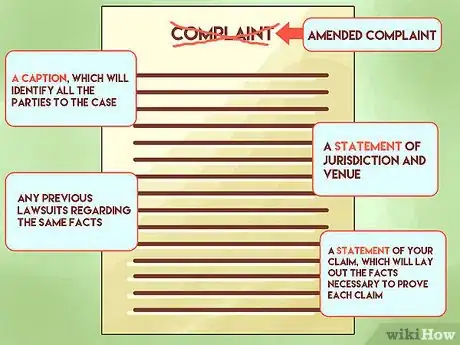This article was co-authored by Clinton M. Sandvick, JD, PhD. Clinton M. Sandvick worked as a civil litigator in California for over 7 years. He received his JD from the University of Wisconsin-Madison in 1998 and his PhD in American History from the University of Oregon in 2013.
There are 9 references cited in this article, which can be found at the bottom of the page.
This article has been viewed 26,711 times.
A demurrer, often called a motion to dismiss, is a motion filed by the other party claiming that your complaint does not establish a valid cause of action.[1] Demurrers are not often filed, and are usually a waste of time, because courts will usually let you file an amended complaint in order to fix any errors you may have in your original. To oppose a defendant’s demurrer, you can draft your own legal motion, called an “opposition to the defendant’s demurrer.” This is a legal document that you file with the court. In the document, you will argue that your complaint was not defective. You should revisit your legal research and double check that you alleged all required elements for each cause of action raised in the complaint. If you get confused about what to write or if you have questions, then you should contact a lawyer.
Steps
Performing Research
-
1Read the demurrer. In a demurrer, the defendant will claim that your complaint is legally deficient. Typically, the defendant will argue that you failed to sufficiently allege a cause of action by leaving out a required element.[2]
- Take out your complaint and read it side by side with the defendant’s demurrer. Check to see if the defendant has accurately summarized your complaint.
-
2Find how long you have to respond. You should read your state’s rules of civil procedure to see how much time you have to respond to the demurrer. You can find the rules of civil procedure online by typing “your state” and “rules of civil procedure.”Advertisement
-
3Revisit your legal research. Check to see that you sufficiently alleged your causes of action. For example, if you sued for negligence, then you needed to allege at least four elements: (1) the defendant owed you a duty, (2) the defendant breached that duty, (3) that breach injured you, and (4) you suffered injuries.[3] If you forgot to allege one of these elements, then your complaint is deficient.
- However, if you alleged all elements, then you should oppose the defendant’s demurrer. You will argue that your complaint was not legally defective.
-
4Check that you filed in the correct court. In some states, a defendant can file a demurrer if you filed the complaint in the wrong court. For example, you might have filed a patent lawsuit in your state court when it should have been brought in federal court.
- The defendant might argue that your cause of action is barred by federal law. This is called “pre-emption.” Unfortunately, you can’t learn pre-emption law on your own. In this situation, you should meet with an attorney. Ask the attorney whether or not the demurrer has merit.
Filing an Amended Complaint
-
1Ensure the court will allow an amended complaint. Most states, as well as the federal government, allow you to amend your complaint once without any questions. However, you can only take advantage of this if you amend your complaint within 21 days of serving your original on the defendant. If you are past this time period when you receive the demurrer, you will need the court's permission (or the defendant's) in order to amend your complaint. According to the federal rules, the court should freely allow an amended complaint if justice requires. Therefore, it should be relatively easy to get permission to file an amended complaint.[4]
-
2Draft the amended complaint. Your amended complaint will completely replace your original complaint. This means your amended complaint must contain all of the requirements necessary for any original complaint. The only differences will be your substantive changes and the title of your complaint, which will say "Amended Complaint" as opposed to "Complaint." Your amended complaint must contain the following:[5]
- A caption, which will identify all the parties to the case
- A statement of jurisdiction and venue
- Any previous lawsuits regarding the same facts
- A statement of your claim, which will lay out the facts necessary to prove each claim
-
3File your amended complaint before any demurrer hearing. If you file your amended complaint before any hearings on the demurrer, you may be able to short circuit the entire demurrer process. By doing this, the court may find the demurrer action to be moot and deny the demurrer altogether. To file an amended complaint, take them to the courthouse where you filed your original. Give the original amended complaint to the clerk of courts. Once he or she accepts them, you will have to pay a filing fee for the amendment. This fee will be smaller than your original filing fee.
- Once you pay, the clerk of courts will stamp your amended complaint as "filed" and will return copies to you. One of the copies will be yours to keep while the other copy will be used to serve the defendant.[6]
-
4Serve the other party. The defendant will need to be made aware of your amended complaint, which is accomplished by serving them with a copy of the amended paperwork. You can complete the service in the same manner as when you served the original complaint. If you are personally serving the defendant, you must have someone over 18 years old who is not a party to the action serve the defendant. For a small fee, you can hire the sheriff or U.S. Marshal to complete service for you.[7]
Drafting Your Opposition Motion
-
1Format your document. You will need to insert a caption at the top of the page. The caption contains the name of the court, the name of all parties, the case number, and probably the judge’s name.[8] You can get this information off the defendant’s demurrer.
- You may have to print the opposition to demurrer on pleading paper. This paper is numbered down the left-hand side. You can get this paper from a stationery store or download it from the Sacramento County Public Law Library.[9]
-
2Add an introduction. In your introduction, you briefly summarize why you are opposing the defendant’s demurrer. For example, you could say that the defendant has misquoted the law and misread your complaint.
- You could write: “Defendant contends that Plaintiff has not pled and cannot allege sufficient facts for any cause of action. To support its argument, Defendant misstates the law and omits allegations from the complaint. Accordingly, Defendant’s Demurrer is without merit.”[10]
-
3State the standard of review. Below your introduction, insert the word “Argument” in bold, all caps. Make sure it is centered between the left- and right-hand margins. Underneath the heading, you should briefly explain how a court is to review a demurrer. In most states, the standard of review is incredibly generous to the plaintiff. This means your opposition motion will have a great chance of success. You may have to do more legal research to find the standard of review.
- In California, for example, you could write, “A court is to assume all facts pled in the complaint are true and may not consider facts asserted in memorandum supporting demurrer.” This is a good basic principle of law. Also cite the court opinion that explains this standard of review.[11]
-
4Explain why your complaint was sufficient. Now you need to respond to the demurrer, argument for argument. If the defendant argued that you did not plead a cause of action sufficiently, then you need to explain to the judge why your pleading was sufficient. Defend each cause of action separately.
- You should restate the elements of the legal claim. Cite to an authoritative statute or court opinion.
- Then you should refer back to the complaint and point out how you alleged sufficient information in your complaint. Be sure to cite to the paragraphs in your complaint so that the judge can find what you are referring to.
- If the defendant argued about facts in the demurrer—for example, by challenging your version of events—then you should state, “Defendant’s demurrer to Plaintiff’s complaint is based on a selective interpretation of facts. Consequently, Defendant highlights issues of fact that are to be decided by the trier of fact and not issues of law needed to sustain a demurrer.”[12] You should make this argument to remind the judge that he or she must assume the facts in your complaint are true for purposes of ruling on the demurrer.
-
5Add a conclusion. In your conclusion, you should restate that the complaint was sufficient and ask the judge to overrule the demurrer. Set off this section with the heading “Conclusion” in all caps, bolded.
- For example, you could write, “For the foregoing reasons, the Complaint in this matter is detailed and complete. Defendant’s challenge to the facts should be decided on their merits rather than inappropriate technical challenges to the pleadings. Accordingly, this Court should overrule Defendant’s demurrer.”[13]
-
6Add your signature. Make sure to include a signature block with your name and address. Also add the date that you are signing your motion.[14]
Filing the Opposition Motion
-
1File your opposition to demurrer. Make several copies of your motion. Take the copies and the original to the court clerk. Ask to file the original.
- Also ask the clerk to stamp your copies with the date. Remember to keep one copy for your records.
-
2Serve a copy on the defendant. You always have to give the other side notice that you filed a motion in the case. If the defendant has a lawyer, then you should serve the copy on the defendant’s lawyer.
- You can generally serve a copy in the same manner that you served a copy of the complaint on the defendant. For example, you could have someone 18 or older who is not a party to the lawsuit make hand delivery.
- You may also be able to serve notice through the mail or by sending a fax. Read your state’s rules of civil procedure to find methods acceptable in your state.
-
3Prepare for the hearing. The defendant might file a reply to your opposition. You will receive it before the hearing date. You can prepare for the hearing by reading all of the papers filed. Take out your complaint, the demurrer, your opposition, and any reply from the defendant.
- Be prepared to explain to the judge why your complaint is sufficient. Remember that the judge will assume everything in your complaint is true, so you don’t need to argue facts or present evidence at this hearing.[15]
-
4Refile the complaint. If you lose the demurrer, the court will usually dismiss your case without prejudice. This means you will be able to refile your complaint so long as you do so in accordance with the judge's demurrer ruling. The judge's ruling will state why your complaint was lacking and what needs to be done to fix the problem.
- If your complaint is dismissed with prejudice, which means you cannot refile, you may have to appeal that decision to an appellate court in order to resolve the issue. The appellate court will then have to rule in your favor and reverse the trial court's order in order to allow you to refile your complaint. An appellate court will only rule in your favor if the trial court did not act in accordance with the law. If your case was validly dismissed with prejudice (e.g., if your case was filed in violation of the statute of limitations), you will not be able to bring the case again and the appellate court will not rule in your favor.
References
- ↑ https://www.law.cornell.edu/wex/demurrer
- ↑ http://dictionary.law.com/default.aspx?selected=487
- ↑ http://www.injuryclaimcoach.com/elements-of-negligence.html
- ↑ https://www.law.cornell.edu/rules/frcp/rule_15
- ↑ http://www.nywd.uscourts.gov/sites/nywd/files/ProSe_Forms_amended_complaint_instructions.pdf
- ↑ http://www.nywd.uscourts.gov/sites/nywd/files/ProSe_Forms_amended_complaint_instructions.pdf
- ↑ http://www.nywd.uscourts.gov/sites/nywd/files/ProSe_Forms_amended_complaint_instructions.pdf
- ↑ https://www.icann.org/en/system/files/files/plaintiff-opp-to-demurrer-18may12-en.pdf
- ↑ https://saclaw.org/wp-content/uploads/lrg-responding-to-a-lawsuit.pdf
- ↑ https://www.icann.org/en/system/files/files/plaintiff-opp-to-demurrer-18may12-en.pdf
- ↑ https://www.icann.org/en/system/files/files/plaintiff-opp-to-demurrer-18may12-en.pdf
- ↑ https://www.icann.org/en/system/files/files/plaintiff-opp-to-demurrer-18may12-en.pdf
- ↑ https://www.icann.org/en/system/files/files/plaintiff-opp-to-demurrer-18may12-en.pdf
- ↑ https://www.icann.org/en/system/files/files/plaintiff-opp-to-demurrer-18may12-en.pdf
- ↑ http://www.leagle.com/decision/1983366144CalApp3d222_1352/KISESKEY%20v.%20CARPENTERS'%20TRUST%20FOR%20SO.%20CALIFORNIA













































































